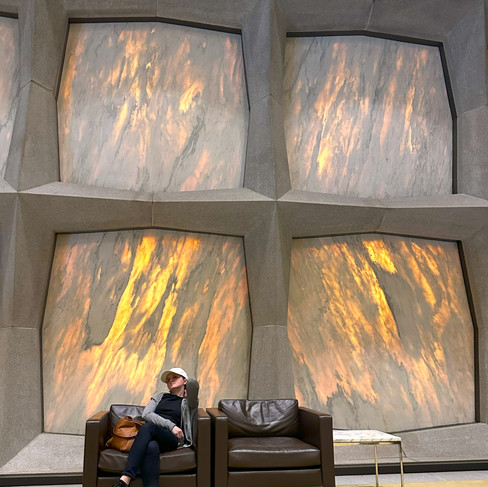To Me, You Are Perfect (My Keira Knightley Building)

Remember that scene in the movie "Love Actually" where the guy is holding up a bunch of signs to Keira Knightley's character telling her how madly in love (with her) he is, and one of them says "To me, you are perfect"? Well that's how I feel about the Bienecke Rare Book Library. For me, it is one of the most beautiful and perfect buildings ever built.

I remember my parents taking us to see the building in the seventies and being absolutely blown away by it. As a child I didn't care about things like insulating values or sustainability, I just found the glowing interior, (thanks to the translucent marble walls) completely magical. Those glowing panels really were imprinted on my brain, right up there with "It's A Small World".

As previously written about, New Haven Connecticut is choc-a-bloc with stunning modernist buildings- including the Beinecke Rare Book Collection which is on the Yale campus. So when Mr. Don't Bruise the Booze and I went to New Haven for a weekend- I wanted to revisit this mythical creature from my memory. But after returning to It's A Small World as an adult and being bitterly disappointed, I was dubious that the building would be as glorious as my memory of it. I am happy to report that unlike the happiest place on earth, (which was quite depressing), the Beinecke was just as magical as I remembered.

The Beinecke Rare Book Library was designed by Gordon Bunshaft of Skidmore, Owings, and Merrill and constructed from 1960-1963. It was originally going to be a competition organized by architect Paul Rudolph, then dean of the school of architecture. SOM was invited to compete, but Gordon Bunshaft refused. His reasoning was that buildings should be designed for, and in conjunction with, the people who are going to use them and that the competition process made that difficult, if not impossible. "I believe one of the most important things in doing a building is writing a program, and that entails almost living with the people who are going to use the building, finding out how they hope to work in it, not listening to their solutions but listening to their needs.”1
Sounds like crazy talk coming from a modernist but apparently the Yale administration found this argument convincing and Bunshaft got the job.

The building was designed with proportions of 1:2:3, height to width to length, making it classical in plan although modernist in style. There are another two floors of storage beneath the plaza. Clearly the architects wanted it to relate to the height of the other buildings on the plaza. The marble panels which cover the building and are cantilevered out beyond the glass lobby level were quarried in Vermont as was the granite frame surrounding each panel. The granite frames hide the steel trusses supporting each panel and transfer the the massive columns in the corners of the cantilever. The lobby level of the building is full height glass allowing glimpses of the treasures within and making the marble building appear to float above the plaza. Despite its classical proportions and scale, the library staff and faculty were outraged by the style of the building which they thought was highly inappropriate in a plaza surrounded by neoclassical style buildings. In fact the assistant librarian was quoted as having called it "...an architect's dream and our future nightmare," (3) Well, Gordon Bunshaft did say listen to their needs not their solutions. Since then the building has become one of the highlights of the Yale campus and is considered a masterpiece of mid-century modern or International style architecture.
The marble panels are thin enough to allow light to penetrate them so that they glow with a wonderful warm color reminiscent, some might say, of a bourbon on the rocks. (Maybe that's why I love this building so much.) Yet they still prevent enough light from entering to create a safe environment for rare books, including a Gutenberg bible. The glass tower containing the rare book collection is at the center of the building, dominating the space and glowing like a literary precursor to HAL. The mezzanine surrounding this literary tower contains exhibition space and seating areas with classic modernist furniture by Florence Knoll and Marcel Breuer. If only there was a bar.
Feeling Thirsty? How about an Applejack Sidecar?
Thirsty For More? Sign Up for our free newsletter here
Shoppables!!!
Notes
(1) Luke Fiederer "Beinecke Rare Book and Manuscript Library/SOM " Arch Daily
(2).Figueres, Enzo (November 2012). "New Haven Architecture" (PDF). The Arts Paper. Arts Council of Greater New Haven.
(3) Klein, Christopher. "Yale’s Beinecke Rare Book and Manuscript Library turns 50." The Boston Globe, April 7, 2013.




















